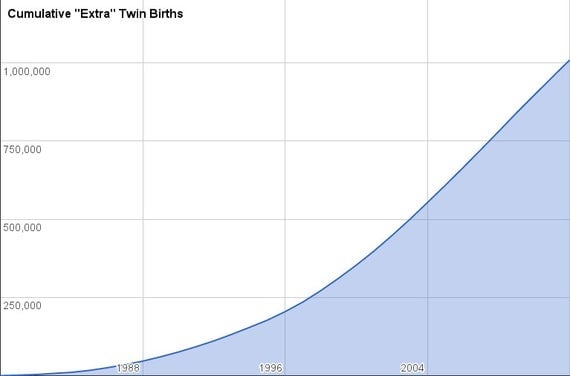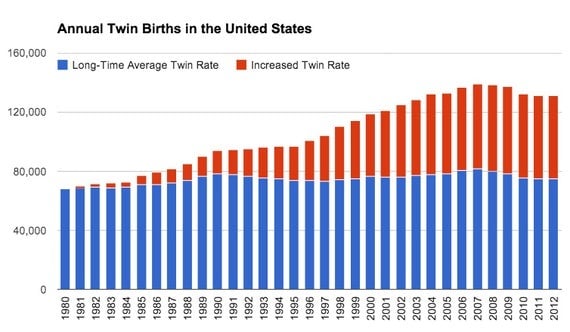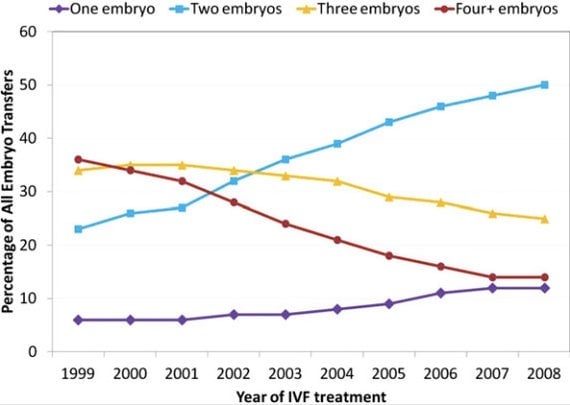Thanks to IVF, the US has one million more twins
From about 1915, when the statistical record begins, until 1980, about one in every 50 babies born was a twin, a rate of 2 percent.

From about 1915, when the statistical record begins, until 1980, about one in every 50 babies born was a twin, a rate of 2 percent.
Then, the rate began to increase: by 1995, it was 2.5 percent. The rate surpassed 3 percent in 2001 and hit 3.3 percent in 2010. Now, one out of every 30 babies born is a twin.
That’s a lot of “extra” twins above the 1980 baseline, but how many?
When the Centers for Disease Control calculated the number through 2009, they pegged it at 865,000. Now that several years more data is available, I recalculated the number. I took the number of twins that would have been born if the 1980 twin rate had held, and subtracted it from how many twins were actually born.
The result: 1,009,337! That’s a million extra twins from 1981 through 2012, the most recent year for which data is available.
A few years ago, CDC researchers looked into the phenomenon. Plural pregnancies have an “unfavorable impact on key indicators of perinatal health such as rates of preterm birth and low birth weight.” So, they wanted to know: what was causing this large increase in twin births?

Older women tend to have more twins than younger women—and older women are having more of the nation’s babies. The researchers found this demographic phenomenon accounted for one-third of the increase.
They attributed the rest of it to the increase in infertility treatments, specifically in-vitro fertilization and “ovulation stimulation medications.”
The increase in the twin birth rate, however, does seem to be leveling off. “The 2012 twin birth rate was 33.1 per 1,000 total births, and was essentially unchanged from 2009-2011,” another CDC report found.

in
Share
More
Computed from CDC data (Alexis Madrigal)
From about 1915, when the statistical record begins, until 1980, about one in every 50 babies born was a twin, a rate of 2 percent.
Then, the rate began to increase: by 1995, it was 2.5 percent. The rate surpassed 3 percent in 2001 and hit 3.3 percent in 2010. Now, one out of every 30 babies born is a twin.
That’s a lot of “extra” twins above the 1980 baseline, but how many?
When the CDC calculated the number through 2009, they pegged it at 865,000. Now that several years more data is available, I recalculated the number. I took the number of twins that would have been born if the 1980 twin rate had held, and subtracted it from how many twins were actually born.
The result: 1,009,337! That’s a million extra twins from 1981 through 2012, the most recent year for which data is available.
A few years ago, the Centers for Disease Control researchers looked into the phenomenon. Plural pregnancies have an “unfavorable impact on key indicators of perinatal health such as rates of preterm birth and low birthweight.” So, they wanted to know: what was causing this large increase in twin births?
Older women tend to have more twins than younger women—and older women are having more of the nation’s babies. The researchers found this demographic phenomenon accounted for one-third of the increase.
They attributed the rest of it to the increase in infertility treatments, specifically in-vitro fertilization and “ovulation stimulation medications.”
The increase in the twin birth rate, however, does seem to be leveling off. “The 2012 twin birth rate was 33.1 per 1,000 total births, and was essentially unchanged from 2009-2011,” another CDC report found.
That is, in part, because assisted reproductive technology procedures have changed. For example, the number of embryos implanted during IVF has a direct relationship with the number of multiple births. So, implanting two (or even three) embryos increases the chance that at least one of them will grow and develop, but simultaneously ups the risk of a plural pregnancy.
In 2000, three or more embryos were implanted in two-thirds of IVF cycles. During the 2000s, though, the Society for Assisted Reproductive Technology and American Society for Reproductive Medicine published guidelines that recommended fewer embryo transfers, particularly for younger women. So, from 2003 until 2010, one study found that the average number of embryos transferred had fallen from 2.6 to 2. In 10 percent of cases, the prospective parents chose to go with a single embryo transfer, too, which was unheard in earlier decades.
These changes have slowed the increase in the twin birth rate, but have not reversed it yet. Still, every year, more than 50,000 extra twins are still born, joining the million others driving their parents crazy.